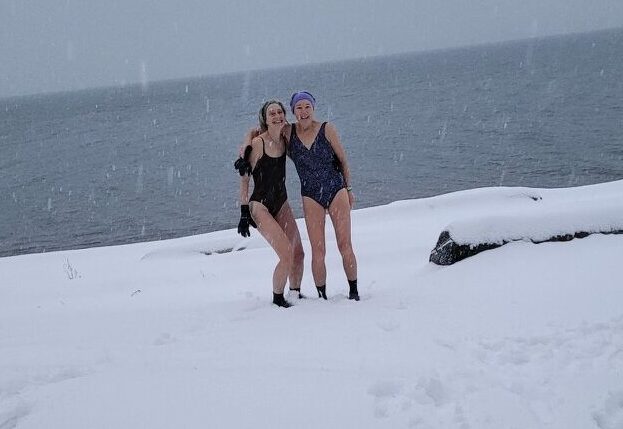By Riley Weeks. This is Part Two in a two-part series about how pollution affects the Salish Sea, the people and animals that rely on it, and what RE Sources and other community advocates are doing about it.
When that large snowstorm hit Bellingham in January 2024, most tried to shelter indoors and stay warm and dry. Kim Brown, an open water swimmer and BEACH program volunteer for Ecology, strapped on her cross country skis instead and made her way down to Marine Park to swim.
“I like the feel of the water. I just love being in it,” Brown said.
She and a group of women from the Bellingham Open Water Swimming group try to cold plunge at least six days a week, year round, rain or shine. Or snow.
Brown has been swimming at Marine Park for the past three years, although has been in and around the ocean for as long as she can remember. Brown grew up on the coast of Southern California and moved to Seattle some forty years ago, where she tried to find lakes to swim in. When she moved to Bellingham, she swam in Lake Padden before deciding to give the ocean a try.

Being in the ocean nearly every day allows for Brown to notice minute changes in current, and describe the water as thick or thin depending on the day and temperature. She knows when a large storm has just occurred by feeling the uneven surfaces of the sand beneath her feet and hands, when she ends her plunge with a handstand. She recalls being underwater one fall watching a maple leaf slowly sink down to the ocean floor.
“It’s amazing [being] tuned in to just the ocean as an element and how many different things you notice about it,” Brown said.
Protecting where we swim
Brown cares about what pollutants are impacting the Salish Sea, not just for her own health, but for the health of the marine mammals that call the Salish Sea home. That’s why she collects water samples for the BEACH program, where agencies and volunteers monitor the safety of saltwater swimming beaches. May through September, Brown collects three samples at Marine Park, either by wading in or extending a large pole out into the water. She collects a sample around six inches from the surface and places it immediately into a cooler. The samples then get sent to a lab for testing.
At the Marine Park site, Brown thankfully doesn’t often see high levels of enterococcus, a bacteria found in poop. But she has seen her fair share of un-scooped dog poop and the occasional oil sheen. Starting in May of this year, Brown will also start to collect samples near Taylor Dock, south of Boulevard Park.
“I’ll go down right where I’ll be sampling with my four-and-a-half-year-old grandson, because he loves tidepooling,” Brown said. “I want to know what’s going on there from a personal standpoint, in addition to the health of the Salish Sea.”
Open water swimming is a great way to feel connected to the ocean, and has myriad health benefits. After a large rainstorm, especially if beforehand was relatively dry, Brown will wait a few days before swimming because those rains flush pollutants accumulated on land into Bellingham Bay. She also won’t swim if Ecology puts out a swimming advisory for the beach she frequents, or if she sees algal blooms in the water.
RE Sources’ North Sound Waterkeeper Kirsten McDade has a few tips for open water swimmers to stay healthy. She advises swimmers to stay out of the water if there are algal blooms or any funky smells, and to shower off after cold plunging. In addition, if you have an open sore or wound, it’s best not to swim until it is fully healed.
Brown also has some tips for beginning swimmers. Be sure to wear neoprene booties and gloves during the winter months, as well as take off wet clothes immediately after plunging. She also advises new swimmers to never plunge alone and to listen to your body.
“I love being in the ocean. I don’t know how to describe it. It’s just such a part of me,” Brown said.
